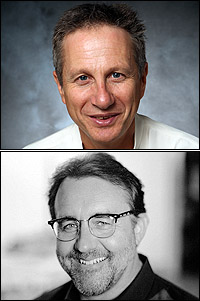
*
When Peter Schneider clocked in as the head of Disney animation in the mid-'80s, the studio division had reached its nadir with a big-budgeted belly-flop called "The Black Cauldron." A creative lethargy had settled over the Magic Kingdom that had once pioneered feature-length cartoons like "Snow White and the Seven Dwarfs," "Fantasia," "Dumbo" and such. The situation got so bad that Jeffrey Katzenberg, the company's No. 2 man (after Michael Eisner), told a newspaper reporter that it was time to "wake up Sleeping Beauty," meaning to shake up the animation department.
"Waking Sleeping Beauty," with its storybook connotation of arousing a sleeping giant, is the title of an "inside job" documentary chronicling Disney's decade-long return to glory — an era of spectacular growth and reasserted imagination when their top-of-the-line output read like previews of coming Broadway attractions: The Little Mermaid, Beauty and the Beast and The Lion King.
(The feature doc gets released in select cities, including New York, on March 26.)
The political machinations of Mickey Mouse's minions — all dramatically played out before Roy Disney (nephew of Walt) during this period of great creative resurgence — are addressed with commendable, Mouse-on-the-couch candor by all hands. "Artistically, from my point of view, [the film] was very successful because people were much more candid in their speaking to us than they would have been with any others," says Schneider, who produced this documentary with director Don Hahn.
 |
||
| Peter Schneider and Don Hahn |
This fact beautifully abets Schneider's desire to recapture, and reclaim from the mists of time, that era of inspired growth. "I think the unique thing about 'Waking Sleeping Beauty' is that it's all done with archival footage," he beams proudly. "There's not anything in the movie that was not shot before 1994, but there are no talking heads, so what you see is footage: you have modern interviews with Jeffrey and Roy and Michael and me and Don and some of the artists, but all the visuals are footage of that time period. Our goal was to transport you back to this period of time and immerse you in all the drama and all the excitement of what was going on."
 |
||
| Ariel from "The Little Mermaid" |
||
| photo by © Walt Disney |
And, of course, the emotional component of the documentary's equation couldn't be more theatrically based. Lyricist-librettist Howard Ashman and composer Alan Menken made their mark Off-Broadway via God Bless You, Mr. Rosewater and Little Shop of Horrors. Ashman's lone Broadway credit while he was alive, Smile, faded fast, so he headed West with Menken, figuring (correctly, it turned out) that animation would be the next logical stop for musical theatre.
"I remember Alan telling me that, when they first arrived at Disney, they were working on the lot in the bungalow next to the Sherman brothers, so the previous generation of Disney songwriters worked side by side with the future generation.
"In terms of emotion," Pacheco continues, "I knew almost immediately that Howard had to be the heart of the documentary — not just because of his early death but because he was so crucial to the studio's comeback. It's hard to underestimate the huge inspiration the Ashman-Menken songs had on the Disney animators. Glen Keane, who specialized in drawing villains, heard the pre-recorded demo of Jodi Benson singing 'Part of Your World' and begged to draw Ariel. The 'Little Mermaid' directors said to him, 'Can you even draw a pretty girl?' And Glen said, 'I've got to draw Ariel. I can feel it in my heart.' It was that kind of inspiration.
"Now, we tend to idolize Howard — and he is deserving of huge encomiums for what he accomplished — but, for all his talent, he could be a demanding and prickly person. Alan had a great line — which is not in the documentary — about how difficult he could be: 'Howard was a self-flagellating artist, and the problem with working with self-flagellating artists is that sometimes they miss — and hit you!'" That kind of balanced reporting makes "Awaking Sleeping Beauty" a consistently entertaining documentary — a credible close-up of a studio getting its groove back.
Read the earlier PlayBlog item about Pacheco's work on "Waking Sleeping Beauty."










